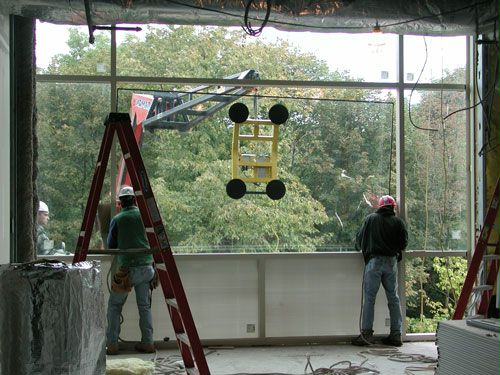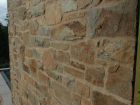Construction of Hamilton's new 192,000-square-foot, $56-million science center is on budget and on schedule, said Douglas A. Weldon, Stone Professor of Psychology and science curriculum and facilities coordinator.
Weldon reported that all the flights of stairs have now been installed, and that the stairwells resemble mini-Atriums. These are often referred to by the project coordinators as "Atriettes" because of their spacious, wall-less design that relies, in part, on the open design for lighting. Bill Huggins, assistant director of construction, added, "At this point in the construction, the building is nearly water tight – most of the roof has been completed, and we've been working hard to get the windows installed. With more than 80 contractors working diligently on a daily basis, things are happening fast."
 |
| The atriette provides access to the Science Center's four stories |
Passersby on Campus Road can now see huge plate glass "store-front windows" on the north side of the building. These windows overlook the ravine and give a clear view of the surrounding valley. Weldon said these floor-to-ceiling windows (each weighing 450 lbs!) enclose some of the research labs and student study areas.
Maybe less glamorous, but just as important, some of the basic interior work is beginning. Sheetrock has already been installed on some of the ground, first and second floors, and casements, cabinets and other millwork are going in. Huggins explained that, in keeping with the College's environmental consciousness, the hardwoods are all "green." The supplier guarantees that the lumber is from managed, sustainable forests. Each tree is tracked from planting to sawmill, Huggins said.
Weldon said the next deadline is to get the turn around by the athletic complex paved in time for the Sacerdote Great Names Event with Bill Cosby.The new Science Building is designed to blend or match the original stone buildings on the north side of campus. Huggins explained that most of the older buildings were constructed using Herkimer dolomite stone, which is no longer available in large quantities. The College ordered 622 tons of Pennsylvania limestone, for use on the outside of the new building. Exterior portions that are not stone feature copper coated with zinc that is manufactured by the Revere factory in Rome, N.Y.
 |
| A team of five positions a window on the science building's second floor. |
The year-round, tightly timed construction schedule, work crews are creating a new four-story wing (or one side of the H-shaped floor plan) and renovating the existing structure. Once completed, the new center will have nearly double the amount of space currently devoted to science education at Hamilton.
The first phase of the center will house the "wet" labs that require high intensity air handling for chemistry and biology. These departments, as well as the physics department and neuroscience program, will move into the new facility next summer (2004). At that time the psychology and geology departments will move, for a year, into renovated spaces in the Saunders Hall of Chemistry, while additional construction and renovation continues on the existing science complex.
During the 2004-05 academic year, the 1965 wing will be demolished and rebuilt, and the original 1925 Science Building will be renovated, and a new façade will be added. The entire center will be completed by the fall of 2005.
 |
| The attention to detail is apparent in the efforts taken to match the original 1925 Science Building.
|
Faculty input has been instrumental in all stages of the planning and construction. The architects have sought to balance both teaching and research needs, especially since all faculty members will have faculty-student research labs for students to use as they complete their senior projects and other research opportunities.
The new center will feature a wireless computing environment, incorporate the latest safety advances for air handling, and will make more efficient use of space. In addition to a new 125-seat state-of-the-art auditorium, a number of seminar rooms will be especially useful for sophomore seminar classes. "We envision these rooms being used by departments from across campus, not just the sciences," Weldon said.
Another feature that is sure to make the science complex a campus centerpiece is the atrium. Huggins describes it as an architectural "show-stopper," and Weldon is enthusiastic about its educational and environmental value. "We'll be able to teach our students what green technology can do by the features incorporated into the atrium," Weldon said. The new glass facade, which will be constructed on the front side of the existing Science Building, will be partially heated using "geothermal loops." Since the ground temperature is considerably warmer than the air in winter, a heat pump will be used to transfer heat from the soil to the atrium during colder months and vice versa in the summer.
Weldon says, "The architects have worked with experts on environmentally friendly design and this technology will make the atrium a large, pleasant, informal meeting area."
Posted October 6, 2003
